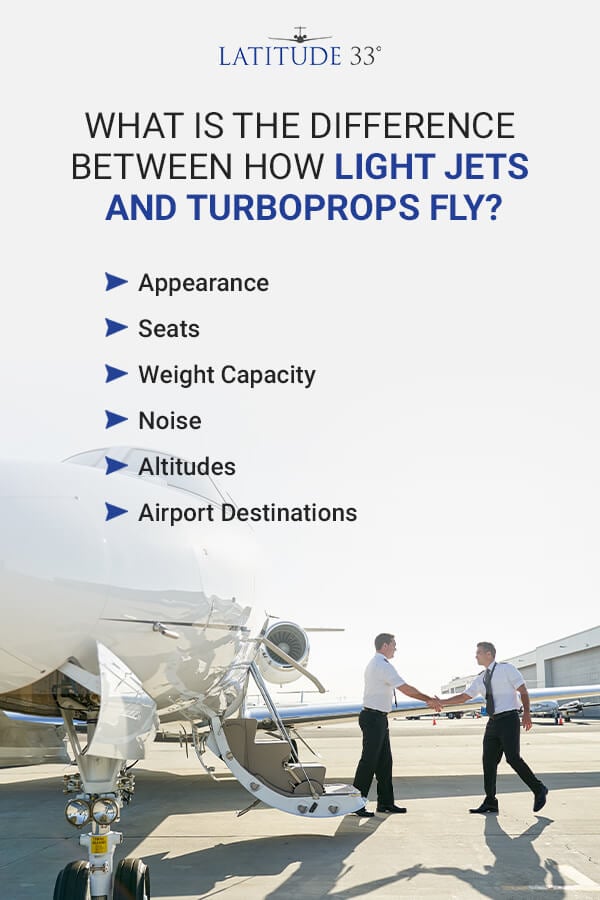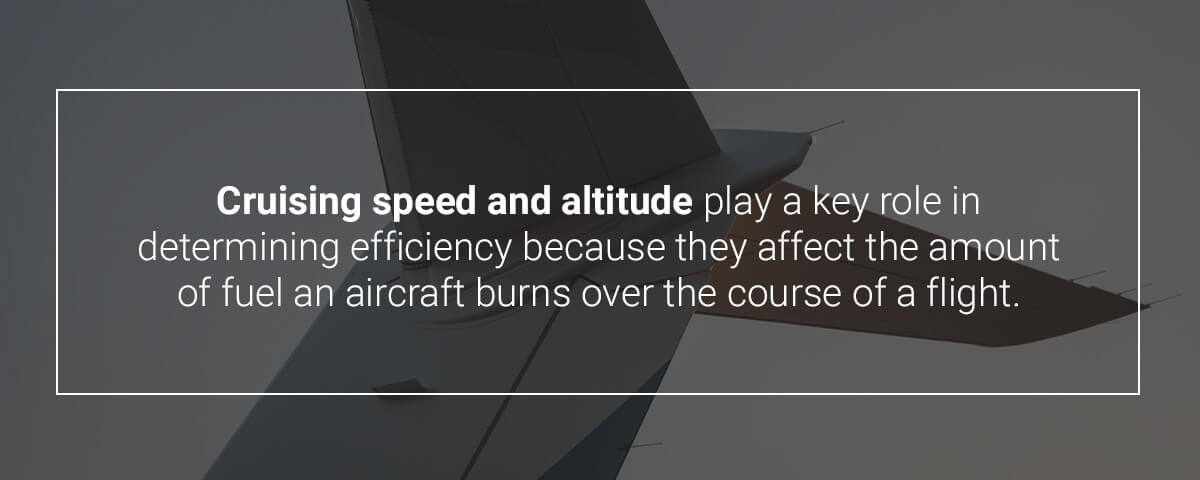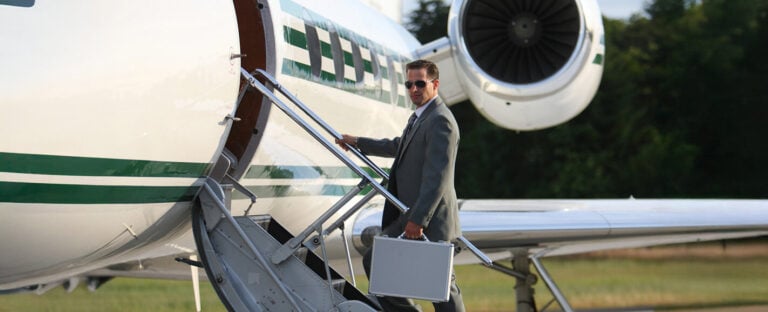While most people are familiar with private jets, not as many people are aware of what a turboprop is or what it offers. If you are considering chartering a private flight, you need to be informed of all your aircraft options. We will compare jet engines vs. turboprops directly to help you determine which type of aircraft would be better suited for your travel needs.
Below, you will discover the differentiating characteristics between turboprops and jets, along with a breakdown of turboprop vs. jet charter costs, operating costs, efficiency, and safety. Keep reading to find out whether a private jet or turboprop is the right choice for your next charter flight.
What Is a Jet?
A jet is an aircraft propelled by jet engines, which are located in even numbers on each side of the aircraft. A jet engine reaches its maximum efficiency at speeds close to or even far faster than the speed of sound. On the other hand, the engines used for propeller-powered aircraft typically reach their maximum efficiency at far lower speeds and altitudes.
The internal combustion engines used by jets are similar to the engines found in trucks, cars, and other automobiles powered by gas. While in flight, these internal combustion engines burn a combination of fuel and air to generate propulsion. As the fuel and air are forced into the jet engines’ combustion chambers, they ignite, and the exhaust gases get released from the back of the engines, propelling the jet forward.
Jets are available in a wide variety of sizes and capacities. However, most jets are powered by either two or four jet engines. Light private jets are smaller than commercial jets and can feature comfortable amenities, such as electronics, a refreshment center, a private lavatory, and reclining leather seats.
What Is a Turboprop Aircraft?
A turboprop aircraft, which is short for turbo propeller aircraft, is a more recent invention than the jet. It uses a turbine engine to drive an aircraft propeller. Instead of relying on jet exhaust, a turboprop aircraft uses gas power to drive a propeller and generate thrust — one of the necessary reaction forces for flight.
More specifically, a turboprop engine is powered by an intake, compressor, reduction gearbox, turbine, combustor, and propelling nozzle. The intake draws air in, which then gets compressed by the compressor before fuel is added. The mixture of fuel and air combusts, allowing hot combustion gases to expand throughout the turbine. Finally, the gases are exhausted from the rear of the engine and used primarily to drive the propeller.
The large diameter of a turboprop aircraft’s propeller enables it to accelerate a large volume of air. In this way, a turboprop is an extremely efficient aircraft because it can accelerate a large amount of air by a small degree at low speeds. A turboprop aircraft is a wise choice for any traveler who values fuel efficiency or wants to fly in and out of smaller airports more easily.
What Is the Difference Between How Light Jets and Turboprops Fly?
If you are debating whether to choose a turboprop or light jet for your next trip, consider the sections below regarding the appearance, seats, weight capacity, noise, altitudes, and airport destinations for each type of aircraft.
Appearance
If you were to look at a light jet and turboprop aircraft side-by-side on a runway, you would be able to identify their differences quickly. A turboprop has obvious propellers on its exterior, whereas a light jet does not. For a smaller light jet, the aircraft will feature two jet engines, with a single engine on each side.
Although a private jet may have a sleeker appearance from the outside, the interiors of both a private jet and a turboprop aircraft are sophisticated and comfortable. Both types of aircraft include high-quality amenities to ensure all your in-flight needs are met so that you can enjoy a relaxing trip.
Seats
Private jet and turboprop aircraft offer equally refined interiors. Whether you choose a turboprop or a light private jet, you will enjoy a relaxing flight with amenities tailored to your specifications. Both types of aircraft feature plush leather seats with easy reclining for maximum in-flight comfort.
Most turboprop aircraft also boast versatile seating arrangements that can comfortably seat up to 11 passengers. Some turboprop seats can also be removed for the sake of storing extra cargo. On the other hand, most light private jets have the cabin and luggage space to seat up to eight passengers comfortably. However, a larger private jet, such as a heavy jet, can seat up to 12 passengers with lie-flat sleeping options.
Weight Capacity
The precise weight capacity of a private jet or turboprop aircraft will vary slightly depending on the model. For instance, a heavy private jet can take considerably more baggage and equipment than a light private jet. Alternatively, midsize and super-midsize private jets are excellent in-between options, with up to 127 ft3 or 135 ft3 of baggage capacity, respectively.
In general, a turboprop aircraft will be most comparable to a light private jet, with about 40-70 ft3 of baggage capacity. However, some seating can be removed from a turboprop to create room for more cargo. While a turboprop or light private jet is a great choice for short trips, travelers who need closer to 200 ft3 of baggage capacity will want to consider a heavy private jet.

Noise
In general, jets have quieter engines than turboprop aircraft. Although the propeller of a turboprop makes this aircraft noisier than a jet, the increase in sound is slight. Most of the turboprop options on the market incorporate modern soundproofing technology that silences the noise of the propeller in the cabin at all times except during takeoff.
Altitudes
Turboprops are designed to fly at lower altitudes than jets, making turboprop aircraft less recommended for bad weather. A turboprop is more prone to be influenced by weather and turbulence at the lower altitude it flies at. In comparison, a jet can cruise casually through rougher weather at a higher altitude.
However, when a turboprop is flown at the correct altitude and airspeed on a clear day, it is remarkably efficient and requires less fuel than most light private jets. These cost-effective qualities make a turboprop an extremely attractive option when the weather is stable.
Airport Destinations
Flying in a turboprop provides you with more airport destinations to choose from than when you travel in a larger private jet. Because turboprops are smaller than most private jets, they can take off from shorter runways and access more airports. The superior short-field takeoff and landing capabilities of turboprops can let you land at a smaller airport closer to your destination or help you reach some of the nation’s most difficult-to-reach airports.
Some of the most popular airport locations for turboprops and private jets include:
- Long Beach Airport (LGB — Los Angeles)
- McCarran International Airport (LAS — Las Vegas)
- Van Nuys Airport (VNY — Los Angeles)
- Carlsbad Airport (CRQ/CLD — San Diego)
Comparing Charter Costs of Turboprops and Jets
The precise charter cost of a turboprop or jet will depend on the distance you are traveling. However, turboprops are generally far more economical than private jets. Shorter flights, in particular, tend to be better suited for turboprops from an economic standpoint. For shorter regional trips, turboprops are typically less expensive and offer better payload and more comfortable cabins than midsize, super-midsize, or heavy private jets.
In addition to lower charter costs, turboprops also offer the advantage of access to more airports. Turboprops can often land at smaller airports that larger private jets cannot access. Where you can fly is an important factor in choosing your ideal aircraft because landing closer to your ultimate destination can save you time, which is equally valuable as money.
On the contrary, you may prefer a larger private jet for a long-distance or high-speed charter flight. Because turboprop aircraft cruise at slower airspeeds than light jets, they do not provide the same range of capabilities as jets. If you need to get to your destination quickly or travel a far distance, it would most likely make more sense for you to charter a light or midsize private jet.
Ultimately, whenever there are numerous variables involved in your trip, be sure to discuss your most cost-effective options with your charter company.
Turboprop vs. Jet Operating Costs
Although the purchase price for turboprops and jets may be different, many of the operating expenses, such as crew, maintenance, and airport charges, remain similar. Of course, fuel-related operating costs for an aircraft always depend on its size, age, and engine. Depending on the model of turboprop or private jet you are interested in, you may be able to find a better deal for either type of aircraft.
Overall, the average turboprop will entail slightly less operational costs than a jet. Because turboprops are known for their efficiency, you will most likely save on fuel costs. As long as you plan on flying at lower altitudes and making shorter trips, a turboprop aircraft may be the right decision for your aviation needs.

Turboprop vs. Jet Efficiency
Aircraft efficiency revolves around two elements — cruising speed and altitude. Cruising speed is the speed at which an aircraft moves while traveling at its fastest for a long distance. Cruising altitude refers to the height in the sky at which an aircraft flies for most of a trip. Both factors play a key role in determining efficiency because they affect the amount of fuel an aircraft burns over the course of a flight.
As a more recent invention than the jet engine, the turboprop aircraft was designed specifically to optimize efficiency at slower speeds and low altitudes. When flown at the right cruising speed and altitude, a standard turboprop requires less fuel than most light jets. This high efficiency makes turboprops a cost-effective and attractive solution for regional charter flights and same-day round-trip charter flights.
However, a jet may be the more efficient choice for longer routes. Jets are generally faster than turboprops, allowing them to cover farther distances more quickly — as long as they have enough time to get to their high cruising speed and altitude. Climbing to a higher altitude with thinner air allows jets to experience less drag and improve their fuel economy, making them exceptionally efficient for lengthy flights.
Are Jets Safer Than Turboprops?
When it comes to safety, jets and turboprops are essentially equivalent. Both types of aircraft are powered by turbine engines, making them virtually identical in terms of safety. In general, turbine engines are mechanically simple, light, reliable, and easy to operate. The lower speed at which turboprops are flown may make some pilots feel safer in case of emergency because it allows for more reaction time.
Turboprops may also help some pilots feel more comfortable because they can land on smaller runways and even rougher runways like dirt or grass. Additionally, turboprops have a more balanced field than jets, which refers to how quickly, easily, and safely a pilot can land a plane after reaching takeoff speed. The drag caused by a turboprop’s propeller allows the aircraft to stop much more quickly than a jet.
Although some pilots may feel more secure flying a turboprop, each pilot has their own preferences. As long as you work with a reputable aircraft charter company, you can be confident that your aircraft meets the current safety regulations, regardless of whether you choose a turboprop or private jet.
Turboprop or Jet: Which Should You Choose?
Whether a turboprop or a jet is better for your travel purposes comes down to the details of your trip. If you intend on going on a shorter, regional flight with only a few passengers or want to land at a small airport, a turboprop is most likely your best option. However, if you are planning a longer-distance flight and need more space for luggage, equipment, or amenities, you may want to charter a private jet.
Request a Charter Flight With Latitude 33 Aviation
Whether you decide a turboprop or private jet is the right aircraft for your trip, you can charter your next flight with Latitude 33 Aviation. Our charter flights are available throughout the U.S., including Alaska and Hawaii, and Mexico. We put our clients first as we provide them with the latest aircraft for all their travel needs.
When you fly with Latitude 33 Aviation, you get to bypass the long lines of commercial airlines and enjoy plush leather seats, custom refreshments, in-flight entertainment, and other amenities. Latitude 33 Aviation is also one of the few private jet charter operators in the country to attain the stringent ARGUS Platinum safety rating so that you can feel confident and secure on your charter flight.
Request a quote from Latitude 33 Aviation today to make your next flight unforgettable.







Comments are closed.